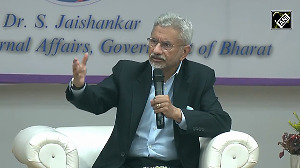The Prime Minister's Office may be patting itself on the back for some reforms it has initiated in the system of evaluating the performance of civil servants.
This may be some progress, in as much as any change is better than no change. But by no stretch of imagination can these reforms be described as either significant or path-breaking.
Take a look at the proposed changes that are ostensibly aimed at making the civil services more efficient and effective.
Instead of the current system of appraising officers on the basis of annual confidential reports, prepared by their seniors, the new approach will be to assess them through a performance appraisal report and a peer review mechanism. How will this be different?
One, an officer will now get to know how his superiors have assessed him. The ACR system did not give him an opportunity to know how his bosses viewed his performance.
It was, after all, a confidential report, to which he had no access. But the PAR system can be expected to introduce transparency and an opportunity for the officers to make mid-course corrections in the way he or she has been functioning.
This is a practice followed by many private sector companies, where an employee is aware of how he has been assessed and the specific areas where he has done well or poorly and where he needs to improve.
Two, the PAR system will hopefully focus not just on the officer's past performance, but also on the future by outlining a path of career progression depending on his aptitude, abilities and past record.
This too is a private sector practice, followed with complete transparency where the appraiser and the appraisee know what goes inside the performance appraisal report.
Three, there will now be a peer group review of performance of senior officers. And the problem starts here.
A small group of very senior officers, whose composition will change periodically, will assess the performance of senior colleagues in the service.
This is going to be a difficult exercise. Indeed, how unbiased, honest and frank such peer group evaluation can be is a moot point, even though we are assured that none other than the prime minister himself will decide on the composition of the peer group to conduct such reviews.
There is no denying that a transition from a closed and secret system of evaluation to one where the officers have the right to know how they are being rated is a positive change.
Equally welcome is the emphasis on outlining the future career path for officers at the time of their annual evaluation.
But these are all marginal changes that seek to correct anomalies in the system that should have been eliminated long ago.
And as pointed out earlier, it is naïve to believe that the IAS system will permit a group of senior officers to make a bold and candid assessment of their colleagues.
Most likely, the advantages to be gained by the introduction of the PAR system will be nullified by the distortions the peer group review mechanism may introduce to the whole exercise.
Instead of taking such half-hearted and misdirected measures, the government would do well to target three broad areas to reform the civil service and make it more effective and efficient.
The main problem the civil service faces today is that it is no longer getting the right talent either at the junior level or at the top. There are a very few good officers left in the service.
Those that remain are either happy serving their tenures in the states or are being grabbed by ministries with more powerful and influential ministers. There is a demand-supply mismatch.
The first solution, therefore, is to create competition by increasing the supply of good officers in the system. In the short run, it can be achieved by immediate induction of top private sector managers in various ministries.
If the pay structure for such private sector entrants has to be made more attractive, the government should lose no time in improving the compensation package for such managers.
An IAS officer should not be allowed to remain complacent in the belief that the government has no option other than considering only officers from the cadre to fill the top vacancies in central ministries.
The long-term solution would be to revive the Industrial Management Pool, which was started in the 1960s, and simultaneously encourage the development of domain knowledge of officers in selected areas of administration.
The IMP had thrown into the government's administrative system several fine officers who during the late seventies and the eighties ran many central economic ministries.
Like the IAS, management graduates and engineers could take a competitive examination and qualify to become a member of the IMP.
Unfortunately, the government did not persist with the IMP examinations for more than a year. Given the paucity of good officers, it is time IMP was revived and to make sure the new scheme works, the compensation package for IMP officers should be made more attractive to draw better talents.
The government would do well to consider introducing one more basic change in the way the civil services are managed in our country.
It must enforce the principle of reward and punishment for civil servants.
While a meritorious officer should be rewarded with faster promotions and higher increments, the evaluation system should have a provision for weeding out the inefficient officers by giving them an exit route.
The existing rules allow officers to seek a voluntary exit from service on completion of a minimum number of years of service.
These rules should be modified to give the voluntary retirement option to all officers attaining the age of 40 years and not found suitable for further promotions.
And those who do not opt out of the service become ineligible for any more promotions.
All these are changes that have been recommended by some government committee or the other in the last 30 years.
If the Manmohan Singh government has the courage and commitment to usher in real reforms in the civil services, all it needs to do is to start implementing them without losing any more time.






 © 2025
© 2025